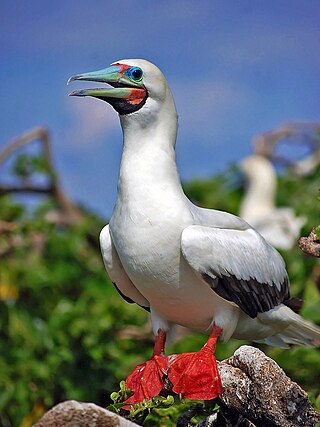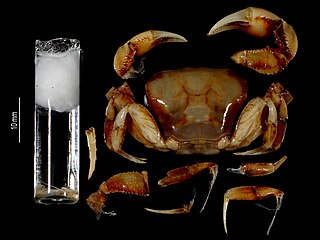
Natura 2000 is a network of nature protection areas in the territory of the European Union. It is made up of Special Areas of Conservation and Special Protection Areas designated under the Habitats Directive and the Birds Directive, respectively. The network includes both terrestrial and Marine Protected Areas.

The International Union for Conservation of Nature (IUCN) is an international organization working in the field of nature conservation and sustainable use of natural resources. Founded in 1948, IUCN has become the global authority on the status of the natural world and the measures needed to safeguard it. It is involved in data gathering and analysis, research, field projects, advocacy, and education. IUCN's mission is to "influence, encourage and assist societies throughout the world to conserve nature and to ensure that any use of natural resources is equitable and ecologically sustainable".

The International Union for Conservation of Nature (IUCN) Red List of Threatened Species, also known as the IUCN Red List or Red Data Book, founded in 1964, is an inventory of the global conservation status and extinction risk of biological species. A series of Regional Red Lists, which assess the risk of extinction to species within a political management unit, are also produced by countries and organizations.

The yellow crazy ant, also known as the long-legged ant or Maldive ant, is a species of ant, thought to be native to West Africa or Asia. They have been accidentally introduced to numerous places in the world's tropics.

The crab-eating macaque, also known as the long-tailed macaque or cynomolgus macaque, is a cercopithecine primate native to Southeast Asia. As a synanthropic species, the crab-eating macaque thrives near human settlements and in secondary forest. Crab-eating macaques have developed attributes and roles assigned to them by humans, ranging from cultural perceptions as being smart and adaptive, to being sacred animals, being regarded as vermin and pests, and becoming resources in modern biomedical research. They have been described as a species on the edge, living on the edge of forests, rivers, and seas, at the edge of human settlements, and perhaps on the edge of rapid extinction.

The Christmas Island red crab is a species of land crab that is endemic to Christmas Island and Cocos (Keeling) Islands in the Indian Ocean. Although restricted to a relatively small area, an estimated 43.7 million adult red crabs once lived on Christmas Island alone, but the accidental introduction of the yellow crazy ant is believed to have killed about 10–15 million of these in recent years. Christmas Island red crabs make an annual mass migration to the sea to lay their eggs in the ocean. Although its population is under great assault by the ants, as of 2020 the red crab had not been assessed by the International Union for Conservation of Nature (IUCN) and it was not listed on their Red List. The crab's annual mass migration to the sea for spawning is described as an "epic" event. Millions emerge at the same time, halting road traffic and covering the ground in a thick carpet of crabs.

The red-footed booby is a large seabird of the booby family, Sulidae. Adults always have red feet, but the colour of the plumage varies. They are powerful and agile fliers, but they are clumsy in takeoffs and landings. They are found widely in the tropics, and breed colonially in coastal regions, especially isolated islands such as St. Brandon, Mauritius. The species faces few natural or man-made threats, although its population is declining; it is considered to be a least-concern species by the International Union for Conservation of Nature (IUCN).
The conservation status of a group of organisms indicates whether the group still exists and how likely the group is to become extinct in the near future. Many factors are taken into account when assessing conservation status: not simply the number of individuals remaining, but the overall increase or decrease in the population over time, breeding success rates, and known threats. Various systems of conservation status are in use at international, multi-country, national and local levels, as well as for consumer use such as sustainable seafood advisory lists and certification. The two international systems are by the International Union for Conservation of Nature (IUCN) and The Convention on International Trade in Endangered Species of Wild Fauna and Flora (CITES).

The Persian sturgeon is a species of fish in the family Acipenseridae. It is found in the Caspian Sea and to a lesser extent the Black Sea and ascends certain rivers to spawn, mainly the Volga, Kura, Araks and Ural Rivers. It is heavily fished for its flesh and its roe and is limited in its up-river migrations by damming of the rivers. Young fish feed on small invertebrates, graduating to larger prey such as crabs and fish as they grow. The threats faced by this fish include excessive fishing with the removal of immature fish before they have bred, damming of the rivers, loss of spawning areas and water pollution. The International Union for Conservation of Nature has listed the fish as critically endangered and has suggested that the increased provision of hatcheries could be of benefit.

Afrithelphusa is a genus of freshwater crabs in the family Deckeniidae. It contains four species, all of which were formerly listed as critically endangered by the International Union for Conservation of Nature (IUCN). They are all endemic to the Upper Guinean forests of Guinea and Sierra Leone.
Protected areas of Sri Lanka are administrated by Department of Forest Conservation and Department of Wildlife Conservation of Sri Lanka.There are 501 protected areas in Sri Lanka. The protected areas that fall under supervision of the Department of Forest Conservation include forests defined in National Heritage Wilderness Area Act in 1988, forest reservations, and forests managed for sustainability. Sinharaja Forest Reserve is an example for a National Heritage forest. There are 32 forests categorized as conservation forests including Knuckles Mountain Range. Strict nature reserves, national parks, nature reserves, forest corridors, and sanctuaries recognized under the Flora and Fauna Protection Ordinance are managed by Department of Wildlife Conservation. Total of all protected areas is 1,767,000 ha. Protected areas in Sri Lanka account for 26.5 percent of the total area. This is a higher percentage of protected areas than in all of Asia and much of the World.

Southwestern Sri Lanka rivers and streams is a freshwater ecoregion in Sri Lanka. The ecoregion is listed in Global 200, a list of ecoregions compiled by the World Wide Fund for Nature for conservation priorities. The extensive network of rivers and streams of Sri Lanka drains a total of 103 distinct natural river basins. Several waterfall habitats have been formed as a result of rivers and streams flowing through high and mid elevation areas. The ecoregion spreads over 15,500 km2 in the wet zone of the southwestern part of Sri Lanka. More than a quarter of the freshwater fishes that have been discovered in Southwestern Sri Lanka rivers and streams are endemic. Nine endemic genera of freshwater fishes of Western Ghats and Sri Lanka hotspot Malpulutta are found only in Sri Lanka. Studies suggest that the number of species still to be discovered is quite high. Until recently wetlands in Sri Lanka were used for drainage, construction sites and land fills.

The coconut crab is a terrestrial species of giant hermit crab, and is also known as the robber crab or palm thief. It is the largest terrestrial arthropod known, with a weight of up to 4.1 kg (9 lb). The distance from the tip of one leg to the tip of another can be as wide as 1 m. It is found on islands across the Indian and Pacific Oceans, as far east as the Gambier Islands, Pitcairn Islands and Caroline Island and as far west as Zanzibar. While its range broadly shadows the distribution of the coconut palm, the coconut crab has been extirpated from most areas with a significant human population such as mainland Australia and Madagascar.
Johora singaporensis, the Singapore stream crab or Singapore freshwater crab, is a critically endangered species of freshwater crab endemic to Singapore. It grows to a size of 30 millimetres (1.2 in) wide.
A not evaluated (NE) species is one which has been categorized under the IUCN Red List of threatened species as not yet having been assessed by the International Union for Conservation of Nature. A species which is uncategorized and cannot be found in the IUCN repository is also considered not evaluated.
Neostrengeria is a genus of crabs in the family Pseudothelphusidae, containing the following species:

Around 1,300 species of freshwater crabs are distributed throughout the tropics and subtropics, divided among eight families. They show direct development and maternal care of a small number of offspring, in contrast to marine crabs, which release thousands of planktonic larvae. This limits the dispersal abilities of freshwater crabs, so they tend to be endemic to small areas. As a result, a large proportion are threatened with extinction.












